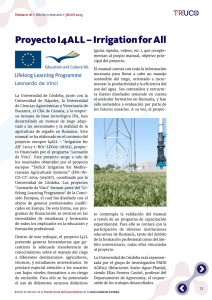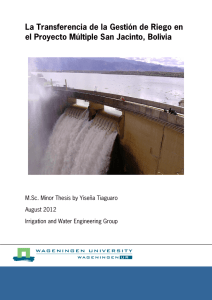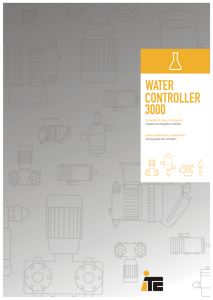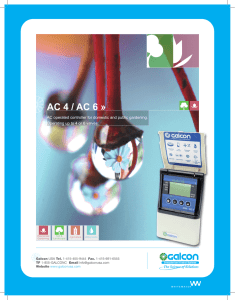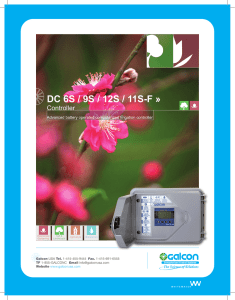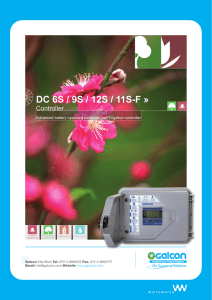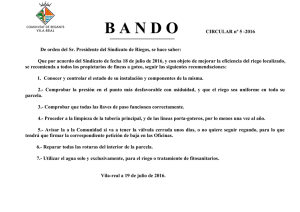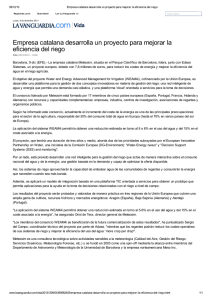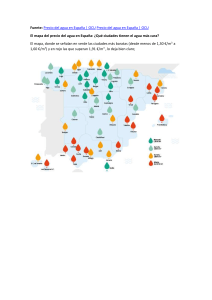DataMerge Brochure
Anuncio
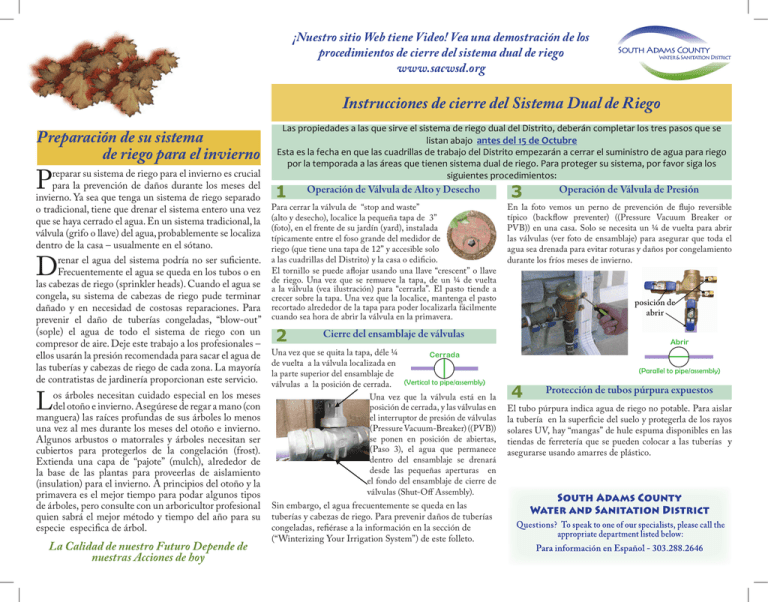
¡Nuestro sitio Web tiene Video! Vea una demostración de los procedimientos de cierre del sistema dual de riego www.sacwsd.org Instrucciones de cierre del Sistema Dual de Riego Preparación de su sistema de riego para el invierno P reparar su sistema de riego para el invierno es crucial para la prevención de daños durante los meses del invierno. Ya sea que tenga un sistema de riego separado o tradicional, tiene que drenar el sistema entero una vez que se haya cerrado el agua. En un sistema tradicional, la válvula (grifo o llave) del agua, probablemente se localiza dentro de la casa – usualmente en el sótano. renar el agua del sistema podría no ser suficiente. Frecuentemente el agua se queda en los tubos o en las cabezas de riego (sprinkler heads). Cuando el agua se congela, su sistema de cabezas de riego pude terminar dañado y en necesidad de costosas reparaciones. Para prevenir el daño de tuberías congeladas, “blow-out” (sople) el agua de todo el sistema de riego con un compresor de aire. Deje este trabajo a los profesionales – ellos usarán la presión recomendada para sacar el agua de las tuberías y cabezas de riego de cada zona. La mayoría de contratistas de jardinería proporcionan este servicio. D L os árboles necesitan cuidado especial en los meses del otoño e invierno. Asegúrese de regar a mano (con manguera) las raíces profundas de sus árboles lo menos una vez al mes durante los meses del otoño e invierno. Algunos arbustos o matorrales y árboles necesitan ser cubiertos para protegerlos de la congelación (frost). Extienda una capa de “pajote” (mulch), alrededor de la base de las plantas para proveerlas de aislamiento (insulation) para el invierno. A principios del otoño y la primavera es el mejor tiempo para podar algunos tipos de árboles, pero consulte con un arboricultor profesional quien sabrá el mejor método y tiempo del año para su especie especifica de árbol. La Calidad de nuestro Futuro Depende de nuestras Acciones de hoy Las propiedades a las que sirve el sistema de riego dual del Distrito, deberán completar los tres pasos que se listan abajo antes del 15 de Octubre Esta es la fecha en que las cuadrillas de trabajo del Distrito empezarán a cerrar el suministro de agua para riego por la temporada a las áreas que tienen sistema dual de riego. Para proteger su sistema, por favor siga los siguientes procedimientos: 1 Operación de Válvula de Alto y Desecho Para cerrar la válvula de “stop and waste” (alto y desecho), localice la pequeña tapa de 3” (foto), en el frente de su jardín (yard), instalada típicamente entre el foso grande del medidor de riego (que tiene una tapa de 12” y accesible solo a las cuadrillas del Distrito) y la casa o edificio. El tornillo se puede aflojar usando una llave “crescent” o llave de riego. Una vez que se remueve la tapa, de un ¼ de vuelta a la válvula (vea ilustración) para “cerrarla”. El pasto tiende a crecer sobre la tapa. Una vez que la localice, mantenga el pasto recortado alrededor de la tapa para poder localizarla fácilmente cuando sea hora de abrir la válvula en la primavera. 2 3 En la foto vemos un perno de prevención de flujo reversible típico (backflow preventer) ((Pressure Vacuum Breaker or PVB)) en una casa. Solo se necesita un ¼ de vuelta para abrir las válvulas (ver foto de ensamblaje) para asegurar que toda el agua sea drenada para evitar roturas y daños por congelamiento durante los fríos meses de invierno. posición de abrir Cierre del ensamblaje de válvulas Una vez que se quita la tapa, déle ¼ Cerrada de vuelta a la válvula localizada en la parte superior del ensamblaje de válvulas a la posición de cerrada. (Vertical to pipe/assembly) Una vez que la válvula está en la posición de cerrada, y las válvulas en el interruptor de presión de válvulas (Pressure Vacuum-Breaker) ((PVB)) se ponen en posición de abiertas, (Paso 3), el agua que permanece dentro del ensamblaje se drenará desde las pequeñas aperturas en el fondo del ensamblaje de cierre de válvulas (Shut-Off Assembly). Sin embargo, el agua frecuentemente se queda en las tuberías y cabezas de riego. Para prevenir daños de tuberías congeladas, refiérase a la información en la sección de (“Winterizing Your Irrigation System”) de este folleto. Operación de Válvula de Presión Abrir (Parallel to pipe/assembly) 4 Protección de tubos púrpura expuestos El tubo púrpura indica agua de riego no potable. Para aislar la tubería en la superficie del suelo y protegerla de los rayos solares UV, hay “mangas” de hule espuma disponibles en las tiendas de ferretería que se pueden colocar a las tuberías y asegurarse usando amarres de plástico. South Adams County Water and Sanitation District Questions? To speak to one of our specialists, please call the appropriate department listed below: Para información en Español - 303.288.2646 Our Website has Video! Watch a Demo of the Dual Irrigation Shutdown Procedures www.sacwsd.org Dual Irrigation System Fall Shutdown Instructions Winterizing Your Irrigation System W interizing your system is crucial to preventing damage from freezing during the winter months. Regardless of whether you have a separate irrigation system or a traditional irrigation system, you must drain the entire system once the water source has been turned off. In a traditional system, the shut-off valve is probably located inside your house - usually in the basement. D Properties served by the District’s dual irrigation system should complete the following steps before the October 15th Shutdown District Crews will begin turning off the irrigation water supply for the season to those areas that have the dual irrigation water system. To protect your system, please perform the following procedures: 1 Stop and Waste Valve Operation To close the “stop and waste” valve, locate the small 3” lid (pictured) in your front yard, typically installed between the large irrigation meter pit (which has a 12” lid and is only accessed by District crews) and the house or building. Grass tends to grow over the lid. Once you locate it, keep the grass trimmed around the lid so you can easily find it when it’s time to open the valve in the Spring. The bolt can be loosened using a crescent wrench or irrigation key. raining the system may not be enough. Water often stays in the pipes and the sprinkler heads. When that water freezes, your sprinkler system can be damaged, and in need of expensive repairs. To prevent damage from frozen pipes, “blow-out” your entire irrigation system with an air compressor. Shut-Off Valve Assembly Leave this job to the professionals - they will use the 2 recommended pressure to push the water out of the Once the lid is removed, turn the valve located on the top Closed pipes and the sprinkler heads from each zone. Most of the Shut-Off Valve Assembly, a 1/4 turn to the closed position. landscape contractors provide this service. (Vertical to pipe/assembly) R emember also that trees need special care in the fall and winter months. Be sure to deep-root water your trees and shrubs by hand once a month throughout the fall and winter months. Some shrubs and trees need to be wrapped to protect them from frost. Spread a layer of mulch around the base of plants to provide insulation for the winter. Early autumn and spring are the best times to prune some types of trees, but consult with a professional arborist who will know the best approach for your specific species. The Quality of our Future Depends on the Actions We Take Today Once the shut-off valve is turned to the closed position, and the valves on the Pressure VacuumBreaker (PVB) are turned to the opened position (Step 3), any water remaining inside the assemblies will drain from the small opening on the bottom of the Shut-Off Assembly. However, water often stays in the pipes and the sprinkler heads. To further prevent possible damage from frozen pipes, refer to the information in the “Winterizing Your Irrigation System” section of this pamphlet. 3 Pressure Vacuum-Breaker Valve Operation Pictured is a typical backflow preventer (Pressure Vacuum Breaker or PVB) on a home. A 1/4 turn is all that is needed to open the valves (refer to assembly photo) to ensure that all water in the device is drained to avoid breaks and damage from freezing during the cold winter months. open position Open (Parallel to pipe/assembly) 4 Protecting Exposed Purple Pipe Purple pipe indicates non-potable irrigation water. To help insulate above-ground pipes and protect them from UV rays, inexpensive foam sleeves are available at hardware stores that can be slipped over the pipe and secured using plastic zip ties. South Adams County Water and Sanitation District Questions? To speak to one of our specialists, please call the appropriate department listed below: Customer Service & Billing - 303.288.2646 Para información en Español - 303.288.2646 Water Quality - 720.206.0563 Conservation - 720.206.0560
